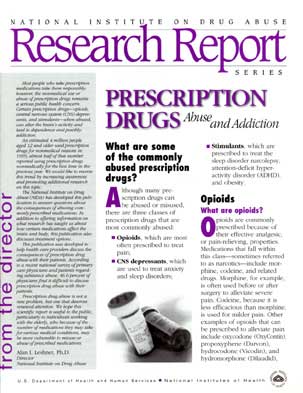
Prescription drugs can help patients manage chronic or severe pain, restore emotional or behavioral balance, control sleep disorders, or fight obesity. When prescription medications are abused, however, the consequences-including addiction-can be dangerous, even deadly. NIDA's newest Research Report focuses on the risks associated with abuse of three classes of commonly abused prescription drugs: opioids; central nervous system (CNS) depressants, including sedatives and tranquilizers; and stimulants.
What are opioids and what are the potential consequences of their use and abuse?
Opioids, include morphine, codeine, and related drugs such as oxycodone (OxyContin), hydrocodone (Vicodin), and meperidine (Demerol) and are commonly prescribed to relieve pain. Opioids can produce drowsiness and, in higher doses, depress respiration. Opioid drugs also can cause euphoria.
Taken as prescribed, opioids can be used to manage pain effectively without untoward side effects. Chronic use of opioids can result in tolerance, which means that users must take higher doses to achieve the same effects. Long-term use also can lead to physical dependence and addiction; withdrawal can occur when an individual discontinues use of the drugs. Withdrawal symptoms may include restlessness, muscle and bone pain, insomnia, diarrhea, vomiting, cold flashes with goose bumps, and involuntary leg movements. Individuals who are addicted to opioids are more likely to overdose on the drugs, which could be fatal.
What are CNS depressants and what are the potential consequences of their use and abuse?
Among the most commonly prescribed CNS depressants are barbiturates, such as mephobarbital (Mebaral) and pentobarbital sodium (Nembutal), which are prescribed to treat anxiety, tension, and sleep disorders; and benzodiazepines, such as diazepam (Valium) and alprazolam (Xanax), which typically are prescribed to treat anxiety, acute stress reactions, and panic attacks. Other benzodiazepines, such as triazolam (Halcion) and estazolam (ProSom), are prescribed for short-term treatment of sleep disorders.
Although the various classes of CNS depressants work differently, they all produce a beneficial drowsy or calming effect in individuals suffering from sleep disorders or anxiety. If one uses these drugs over a long period of time, the will develop tolerance, and larger doses will be needed to achieve the initial effects. In addition, continued use can lead to physical dependence and, when use is reduced or stopped, withdrawal. Both barbiturates and benzodiazepines have the potential for abuse and should be used only as prescribed. As with opioids, overdose of these drugs can be fatal.
What are stimulants and what are the potential consequences of their use and abuse?
Stimulants enhance brain activity, increasing alertness, attention, and energy, raising blood pressure, and elevating heart rate and respiration. Stimulants such as methylphenidate (Ritalin) and dextroamphetamine (Dexedrine) are prescribed for the treatment of narcolepsy, attention-deficit/hyperactivity disorder, and depression that has not responded to other treatments. They also may be used for short-term treatment of obesity.
Individuals may become addicted to the sense of well-being and enhanced energy that stimulants can generate. Taking high doses of stimulants repeatedly over a short time, however, can lead to feelings of hostility or paranoia. Additionally, taking high doses of stimulants may result in dangerously high temperatures and an irregular heartbeat.
